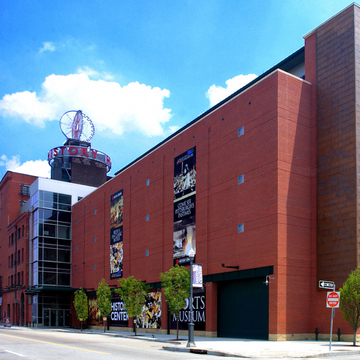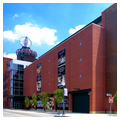You are here
Senator John H. Heinz Pittsburgh Regional History Center
This former ice warehouse is a formidable seven-story red brick building, whose function dictated its enormous construction strength. The ground floor carries low masonry vaults between riveted steel beams, while upperfloor ceilings are of massive timber construction. Windows are narrow and recessed to protect the stored ice from sunlight. Ice blocks entered and left the building on railroad cars that ran directly into the building through the chamfered northeast corner. In 1993, the Historical Society of Western Pennsylvania chose the warehouse as a headquarters that could be equipped with galleries, archives, and meeting rooms. The remodeling presented the designers with numerous challenges. One of the most significant was to provide ventilation, access, and light in a structure built to prevent those things. Inner cagework was removed to form a seven-story atrium, which is topped by a new roof structure and partial clerestory. To the west, an elevator tower, clad in copper and steel and terminating in latticelike steeple shape, was added to the exterior.
In 2004, the Center was expanded by a five-story red brick addition of a simple rectangular shape. It was designed to meet Leadership in Energy and Environmental Design (LEED) certification requirements, in keeping with Pittsburgh's leadership role in environmentally sound architecture. The Center's exhibits celebrate Pittsburgh's heritage of industrial contributions and ethnic diversity—exactly the lessons visible in the streets around it.
Writing Credits
If SAH Archipedia has been useful to you, please consider supporting it.
SAH Archipedia tells the story of the United States through its buildings, landscapes, and cities. This freely available resource empowers the public with authoritative knowledge that deepens their understanding and appreciation of the built environment. But the Society of Architectural Historians, which created SAH Archipedia with University of Virginia Press, needs your support to maintain the high-caliber research, writing, photography, cartography, editing, design, and programming that make SAH Archipedia a trusted online resource available to all who value the history of place, heritage tourism, and learning.





